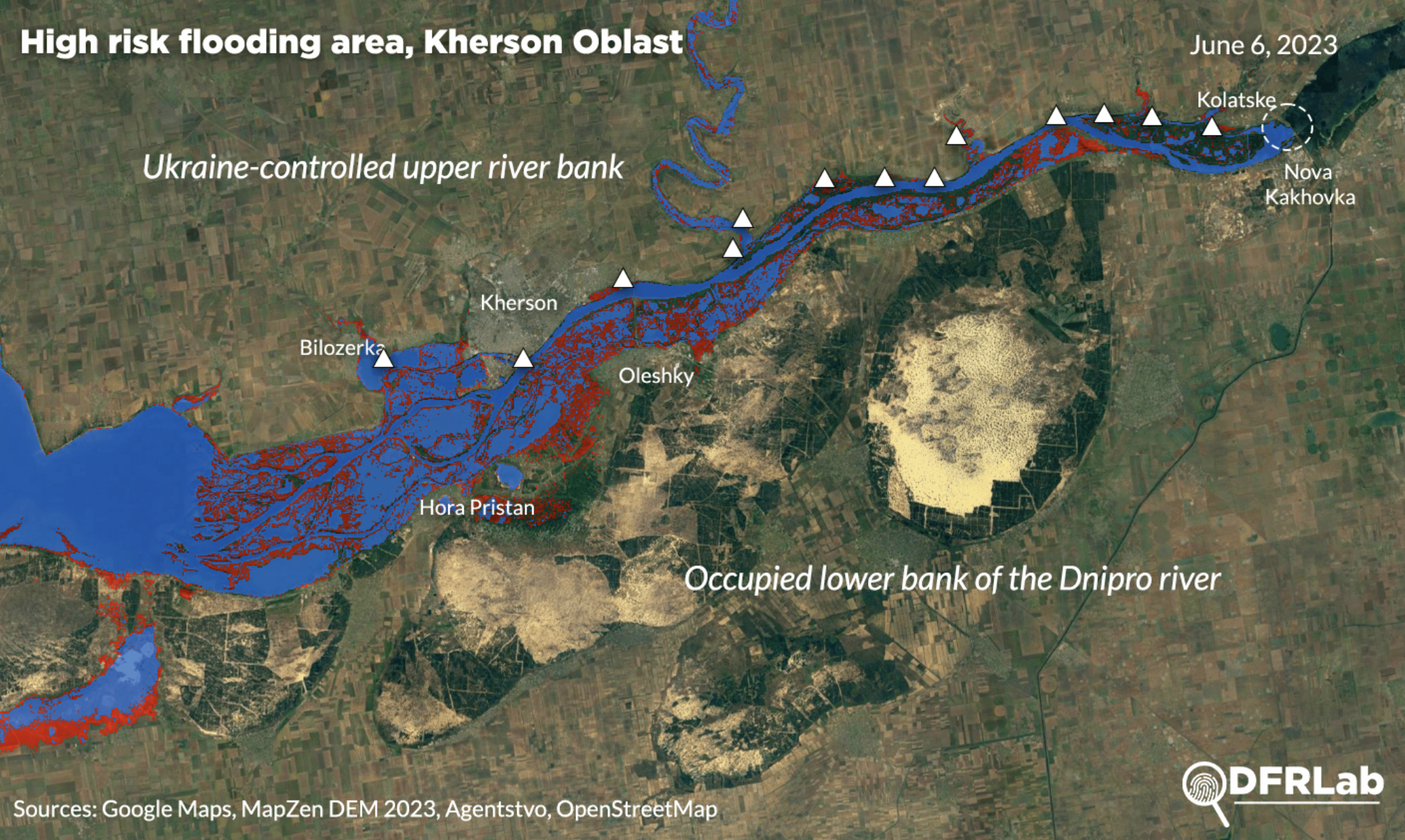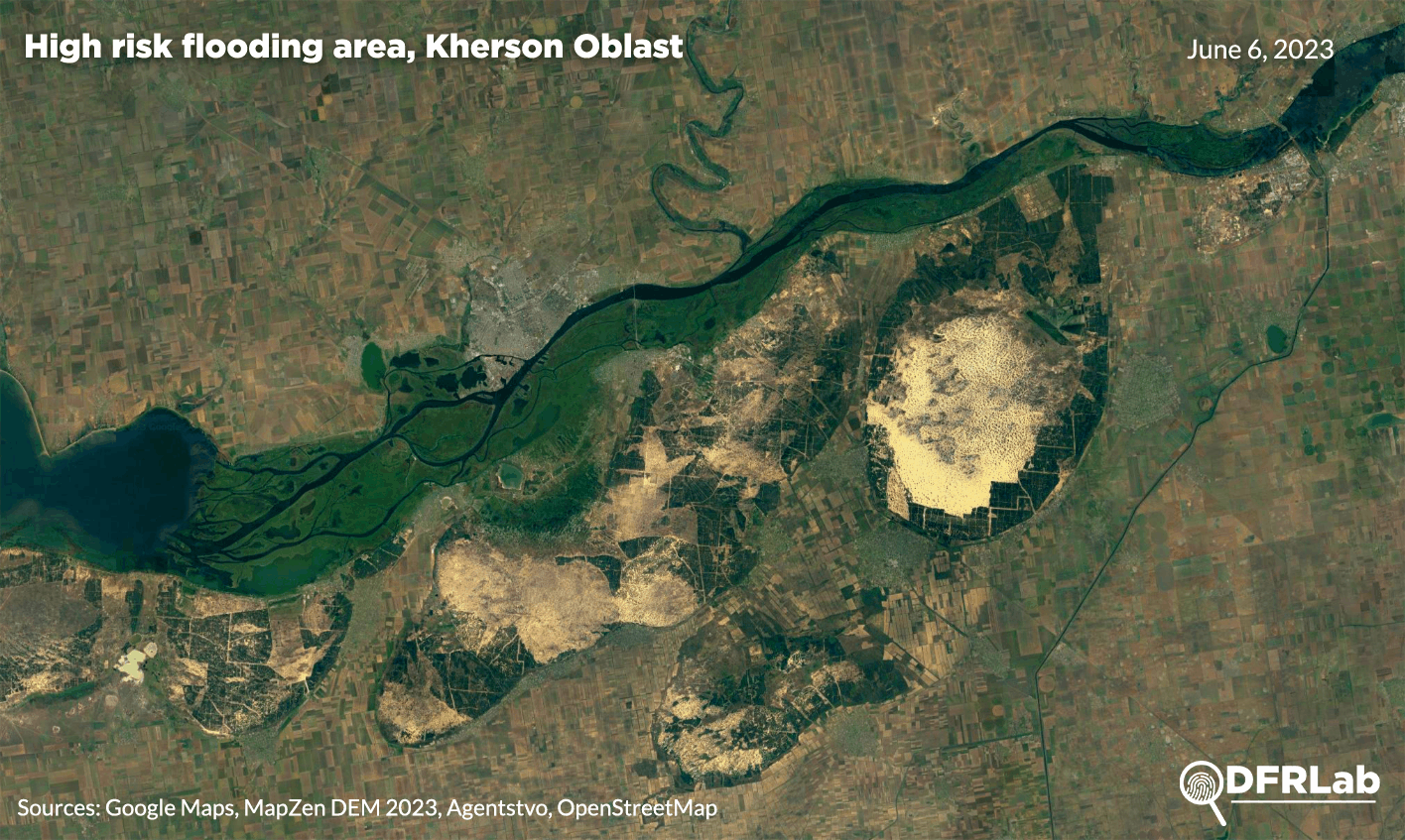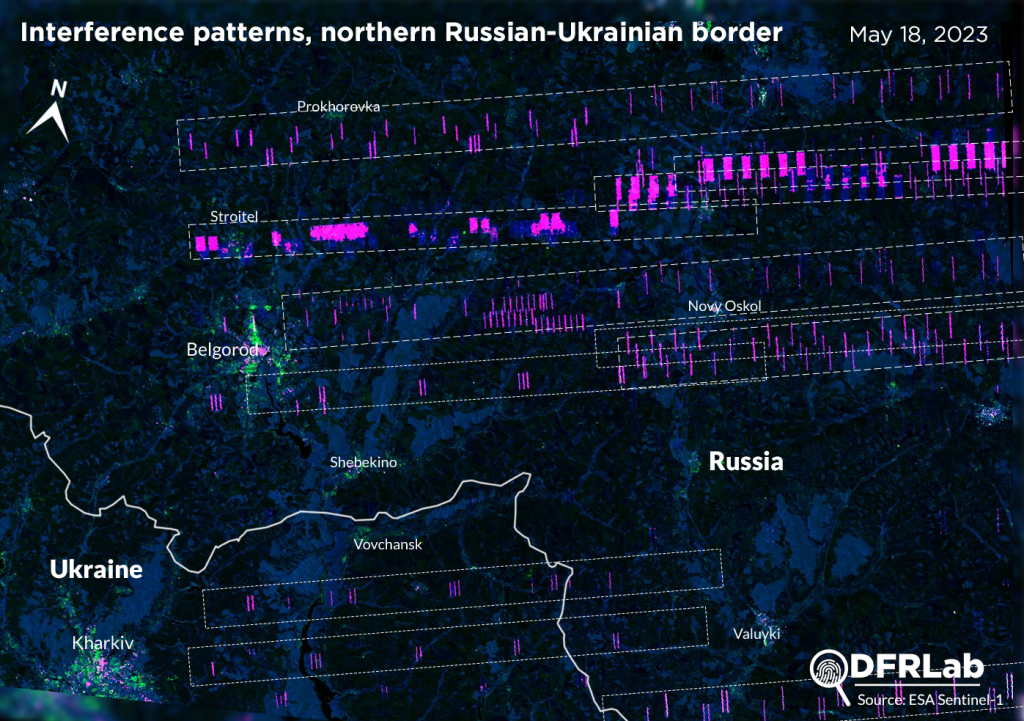Russian War Report: Satellite imagery analysis captures flood threat after dam’s destruction
Satellite imagery of the Nova Kakhovka dam’s collapse reveals the extent of the damage caused by extreme flooding in Kherson Oblast.
Russian War Report: Satellite imagery analysis captures flood threat after dam’s destruction
Share this story

As Russia continues its assault on Ukraine, the Atlantic Council’s Digital Forensic Research Lab (DFRLab) is keeping a close eye on Russia’s movements across the military, cyber, and information domains. With more than seven years of experience monitoring the situation in Ukraine—as well as Russia’s use of propaganda and disinformation to undermine the United States, NATO, and the European Union—the DFRLab’s global team presents the latest installment of the Russian War Report.
Security
Tracking narratives
Nova Kakhovka dam rupture floods acres of civilian settlements in Kherson Oblast
On June 6, satellite imagery published by Maxar confirmed the collapse of the Nova Kakhovka dam in Ukraine. The dam is located downstream of the Zaporizhzhia nuclear power plant, and upstream of the city of Kherson, in southeast Ukraine. Ukraine and Russia continue to blame each other for its destruction.
For months, Russian and Ukrainian armed forces have been facing each other on either side of the riverbank, as Ukraine retook the city of Kherson after Russia claimed to have evacuated the city as “a gesture of good will.” The contents of the Kakhovka reservoir have been flowing downstream into the Kherson region ever since the dam’s rupture, resulting in the flooding of acres of civilian settlements stretching from near the dam down to the mouth of the river along the Black Sea.
The DFRLab collected data from MapZen using Sentinel’s EOBrowser platform. The imagery notably contains a digital elevation model enabling the DFRLab to model high risk areas subject to floods. Using geographic analysis relying on raster calculations, a technique for mapping individual pixels to altitude data, the DFRLab assessed two scenarios of potential flooding downstream of Nova Kakhovka. This information was cross-referenced with other data posted by Russian opposition Telegram channel Agentstvo to assess the extent of the flood.

Agentstvo geolocated footage taken by civilians on either side of the river. The DFRLab added these locations to the above map in an attempt to compare the modeled area to the actual reported locations of flooding. As of June 6, the mapped locations are consistent with areas that would flood if the river rose by just two meters. Footage shows parts of Kherson also subjected to inundation.
Additionally, security concerns are growing as mines located on both sides of the riverbank are at risk of exploding as a result of the rising water level. The Ukrainian Independent Information Agency reported that some Russian mines had already detonated. Villagers and inhabitants on alluvial islands and in Kherson were forced to leave their homes. Furthermore, Russia and Ukraine are blaming one another for the destruction of the dam. While Ukrainian officials accused Russia of bombing the Kakhovka dam to undermine Ukraine’s counteroffensive efforts, Russian Defense Minister Sergei Shoigu said Ukraine committed a “terrorist attack” to “prevent a Russian attack.”
—Valentin Châtelet, research associate, security, Brussels, Belgium
Fighting between Russian volunteers and Russian army escalates in Belgorod Oblast
The fighting continues in Russia’s Belgorod Oblast, a short distance from Ukraine’s northeastern border, but details about the situation remain murky. The Russian Volunteer Corps, an anti-Putin military unit made of Russian pro-Ukrainian partisans, and the Freedom of Russia Legion said they carried out a number of attacks in the region, while Moscow claims to have repelled several attacks.
The Freedom of Russia Legion announced it had destroyed two Russian army tanks, one BMP infantry fighting vehicle, and one BRDM armored vehicle near the Shebekino border crossing in Belgorod on the night of June 4. The veracity of the claim has not been independently verified, however. On June 4, another unconfirmed report appeared on the Telegram channel of Ukrainian journalist Andrii Tsaplienko, citing an unnamed military officer, claiming the Russian army shelled a settlement in the Belgorod region. There have been signs of fighters from the Russian Volunteer Corps being active in Belgorod, so shelling the region could signal an escalation. In addition, the Russian Telegram channel Brief reported that the Ukrainian army shelled Novaya Tavolzhanka in Belgorod Oblast on June 5; this too has not been confirmed. Another Russian Telegram channel reported explosions in Grayvoron, Belgorod Oblast that same day.
One day earlier, the Russian Volunteer Corps said on Telegram that a Polish volunteer unit has been fighting “shoulder-to-shoulder for the freedom and independence of Ukraine for several months.” According to the statement, Russian and Polish fighters jointly carried out “a number of operations” in the areas of Orikhiv, Zaporizhzhia, and Bakhmut. The Polish unit, known as the Polish Volunteer Corps (Polski Korpus Ochotniczy), has published videos of its operations in Bakhmut and Zaporizhzhia on their Telegram channel, which was created in February 2023. According to the Russian Volunteer Corps, the Polish fighters are providing military and medical logistics only within the state borders of Ukraine. The information published by the two military units on Telegram have not been verified independently.
The Polish government has denied it has any involvement with Polish volunteer units. Stanisław Żaryn, the secretary of state for the chancellery of the prime minister of Poland, said on Twitter that the Polish Volunteer Corps are “in no way associated with the Polish Armed Forces or any Polish institution.” According to Polish media outlet Defence 24, the Polish Volunteer Corps was created in February 2023 and operates as part of the Armed Forces of Ukraine. The Polish Volunteer Corps reportedly posted on its Telegram channel that they participated in the combat mission in Belgorod alongside the Russian Volunteer Corps. The Telegram post reportedly argued that “all returned from the mission safely. The task was completed successfully.” However, it appears that the post was later removed, as there are currently no posts in the Telegram channel containing information about the participation of Polish units in the Belgorod raid.
Russian Volunteer Corps fighters also claimed to be holding captive Russian soldiers who were handed over to Ukrainian forces because authorities in Belgorod had shown no desire to retrieve them. At the 1:26 mark in a video posted on June 4 to the Telegram channel of the Russian Volunteer Corps, a dozen men in Russian uniforms are seen. It is possible the men were captured during fighting between the militants and the Russian army in the village of Novaya Tavolzhanka in Belgorod Oblast, though this is unconfirmed. According to The New Voice of Ukraine, the volunteer fighters reached out to Belgorod Governor Vyacheslav Gladkov with an offer to return the captured soldiers as a goodwill gesture. In return, they asked for a private audience with the governor to discuss the present state of the region. The governor has reportedly not responded to the request. Previously, Gladkov described the fighters as “those fascists,” and said they were responsible for “daily civilian deaths.” The Freedom of Russia Legion also claimed to be holding Russian soldiers captive in a video published on their Telegram channel on June 5.
Meanwhile, the Armed Forces of Ukraine stated that Russian forces on June 4 and 5 conducted offensive actions in the Donetsk and Luhansk Oblasts, with the Ukrainian military fighting the Russian army near Novoselivske and Bilohorivka in Luhansk and Ivanivske and Marinka in Donetsk. Ukrainian forces also alleged that a Russian saboteur group attempted to infiltrate the border near Zelene in Kharkiv Oblast. Ukraine added that settlements in Kharkiv, Chernihiv, Zaporizhzhia, and Kherson were shelled by Russia, including a building belonging to Kherson State University.
Meanwhile, Sky News obtained a purported arms contract detailing a purchase agreement between Russia and Iran. According to the contract, Iran supplies Russia with tank and artillery ammunition, as well as barrels for T-72 tanks and howitzers. The sixteen-page document, which has not been independently verified, is dated September 14, 2022, and presents samples of variously sized artillery and tank shells and rockets worth just more than one million dollars.
—Ruslan Trad, resident fellow for security research, Sofia, Bulgaria
—Givi Gigitashivili, research associate, Warsaw, Poland
Interference on satellite imagery points to enhanced military activity on the border between Belgorod and Kharkiv prior to saboteur raid

Satellite Aperture Radar (SAR) imagery from May 18 released by the European Space Agency’s Sentinel-1 satellite shows massive levels of interference in Russia’s Belgorod Oblast. The DFRLab previously reported on similar interference patterns observed in the Black Sea and in Belgorod throughout April 2023. The May 18 imagery indicates that more prominent interference activity took place in Belgorod Oblast, with patterns stretching several hundred kilometers. The imagery was obtained just after midnight local time that morning as the satellite was flying over the border with Kharkiv.
Simultaneously, consistent reports of aerial activity in Belgorod, including missile launches, emerged on Telegram. These patterns were observed nearly one week prior to the Russian Volunteer Corps’ raids in Russia’s border outposts of Shebekino and Grayvoron.
Several smaller interference patterns also stretch east of Kharkiv in Ukraine. These could also be consistent with reports from the Telegram channel Kharkiv Live which indicated Russian aviation raids and artillery rocket launches between 11:58 pm and 12:31 am local time. Local authorities issued an air raid alert between 12:31 and 1:01 am.
—Valentin Châtelet, research associate, Brussels, Belgium
Pro-Kremlin sources contradict each other in laying blame for Nova Kakhovka dam destruction
Pro-Russian Telegram channels, sometimes referred to as “Z channels,” began reporting on the Nova Kakhovka dam around 3:00 am Moscow time, stating that the shelling of the Kakhovka hydroelectric power plant occurred at 2:35 am. Initially, Vladimir Leontev, the Russian-installed mayor of occupied Novaya Kahovka, denied any explosion, shelling, or damage to the dam. In an interview with Kremlin-owned RIA Novosti, Leontev said, “That’s bullshit! Everything is fine, everything is fine everywhere; I just got on the [police] radio. Everywhere everything is normal in the city; everything is quiet and calm.” Further, Kremlin-owned TASS quoted an unnamed source from the Russian authorities as saying, “It was quiet at night. There was no shelling. The dam could not stand, one support collapsed, and flooding began.”
Later, the narrative changed. In a video, Leontev said, “At about 2:00 am there was shelling on Kahovka dam and its valves were destroyed.” RIA Novosti blamed the Armed Forces of Ukraine for the damage that caused the “unregulated discharge of water.” The pro-Kremlin Telegram channel Swodki commented, “Russian positions are located on the lower Dnipro riverbank. The flow of water can erode the line of [Russian] defense on the coast and prevent and repel a potential boat landing of an aircraft of the Armed Forces of Ukraine.” In addition, former Russian commander Igor “Strelkov” Girkin, who played a crucial role in forming the separatist movement in the Donbas, suggested that the dam’s destruction helped Ukrainian forces advance militarily.
The exact cause of its destruction remains unknown. The New York Times reported that some experts believe it was “probably breached” by an “internal blast,” but acknowledged this assessment should be treated “cautiously.” Pro-Ukraine social media pointed fingers at Russia causing the breach, but at times the debate was muddled due to sharing of old footage capturing the explosion of a bridge adjacent to the facility in November 2022.
Meanwhile, some social media posts from pro-Kremlin fighters suggested the dam’s destruction benefits Russia. For example, Russian solider Yegor Guzenko suggested on his Telegram channel Separ13_13 that the destruction of the dam was in Russia’s favor. In one video, he said, “Whoever did it, it is good if no Russian Army soldier suffers. Then it does not matter who did it even if it were [Ukrainians] themselves.” Later, he posted about why the destruction might have been in Ukraine’s favor.
—Nika Aleksejeva, resident fellow, Riga, Latvia
Deepfake impersonating Putin ‘declares’ martial law in Russian regions bordering Ukraine
On June 5, Russian television and radio stations broadcast a clip featuring a deepfake of President Vladimir Putin. In the fabricated “emergency address,” the impersonated Russian president reportedly declared, “Ukrainian troops, armed by the NATO bloc with the consent and support of Washington, invaded the territories of the Kursk, Belgorod, and Bryansk regions.” The Putin deepfake then “announced” martial law in these regions and said that he plans to sign an executive order declaring a general mobilization throughout the country.
The incident was reported in the Russian oblasts of Voronezh, Bryansk, and Belgorod. These regions sit along the border with Ukraine, where frequent drone attacks are reported and armed group incursions forced some to evacuate in May. Kremlin spokesperson Dmitry Peskov declared that Putin did not address the nation and confirmed that “a hack occurred in several regions.” According to Peskov and information posted on the Telegram channel Ukraine Informer, radio stations also broadcast the same message.
Russian State Duma members of parliament have set out to draft a law enforcing the labeling of content created by neural networks.
—Valentin Châtelet, research associate, Brussels, Belgium
Russia recycles false narrative that Ukraine plans to use a ‘dirty bomb’
On June 6, the same day the Novo Kakhovka dam was destroyed, Russia shared a new iteration of its narrative that accuses Ukraine of planning to use a “dirty bomb” against Russia.
Russia’s Federal Security Service (FSB) published a statement in which the agency claimed to have “received additional information on the involvement of the Ukrainian special services in the planning and preparation of acts of international terrorism.” The FSB claimed that Ukraine created an air unit to supply “sabotage and reconnaissance groups on Russian territory” with “dirty bombs.” The statement alleged that Ukraine planned to place dirty bombs in various places, detonate them simultaneously, and “make areas [in Russia] unsuitable for human habitation.”
The DFRLab has previously covered Russian attempts to spread similar disinformation in order to prime audiences for the February 2022 invasion of Ukraine and justify the war. Since then, the DFRLab have observed multiple instances of Russian officials accusing Kyiv of plotting to use a “dirty bomb.”
— Eto Buziashvili, research associate, Tbilisi, Georgia

